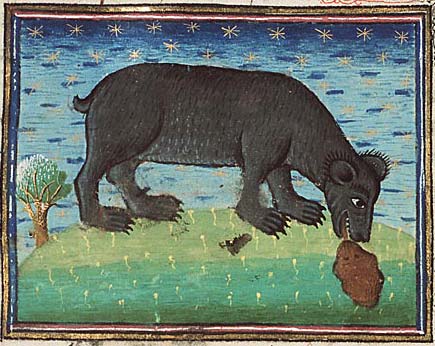Bears, depending on context, might imply one thing or its exact opposite in Christian iconography.St. Euphemia, tradition claims, lived between the 3rd and 4th centuries in Chalcedon in the days of Priscus, who had then decreed all inhabitants of the city should take part in the sacrifices made to Ares, the Greek classic god of warfare. Euphemia was discovered, alongside 49 more Christians, hiding in a house worshiping Christ, defying the governor’s orders.
After being tortured, Euphemia was sent to die in the arena, where wild beasts were supposed to kill her. Hagiography says that, instead of attacking, the beasts (bears included) licked her wounds.
However, some other accounts of her story claim that, whereas lions tried to protect her, a bear killed her in the arena.
The different accounts of the death of St. Euphemia, one version making bears responsible for her death, the other one claiming all beasts protected her, show the complicated place bears occupy in Christian iconography.

Read more:
The meaning of bees and beehives in Christian Art
The bear has often symbolized cruelty. In fact, in the Book of Daniel (Cf. Daniel 7, 5) the bear represents the Kingdom of Persia, which is understood as corrupt and death-bringing:
Another beast appeared, a second one, that looked like a bear. It was raised up on one side, had three tusks in its mouth among its teeth and was told, “Arise, devour many bodies!”
George Ferguson’s classic Signs and Symbols in Christian Art also points out that in the Second Book of Kings, two bears are said “to have appeared from the woods and eaten the children who mocked Elisha because of his baldness”:
While he was going up on the way, some small boys came out of the city and jeered at him, saying, “Go away, baldhead! Go away, baldhead!” When he turned around and saw them, he cursed them in the name of the Lord. Then two she-bears came out of the woods and mauled forty-two of the boys. From there he went on to Mount Carmel, and then returned to Samaria.

But not only biblical sources inform Christian iconography. Old legends, some of them compiled in the Physiologus (a didactic Christian text written or compiled in Greek by an unknown author, consisting of descriptions of animals, birds, and fantastic creatures, sometimes stones and plants, provided with moral content, dated somewhere around the end of the 3rd century) would claim bear cubs were born shapeless, and that their mother would then give them form, “licking them into shape.” This was understood by many as a symbol of Christianity, which re-forms and re-generates the sinner. Because of that reason, bears eventually became symbols of the Church itself.
In fact, according to Ferguson, the many legends including saints taming bears can be interpreted as metaphors for the overcoming of sin, or the evangelization of non-Christian peoples.








